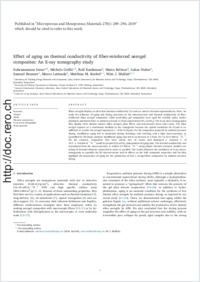Effect of aging on thermal conductivity of fiber-reinforced aerogel composites: An X-ray tomography study
- Iswara, Subramaniam University of Fribourg, Department of Chemistry, Switzerland
- Griffa, Michele Concrete/Construction Chemistry Laboratory, Swiss Federal Laboratories for Materials Science and Technology, Empa, Dübendorf, Switzerland - Center for X-ray Analytics, Swiss Federal Laboratories for Materials Science and Technology, Empa, Dübendorf, Switzerland
- Kaufmann, Rolf Center for X-ray Analytics, Swiss Federal Laboratories for Materials Science and Technology, Empa, Dübendorf, Switzerland
- Beltran, Mario Center for X-ray Analytics, Swiss Federal Laboratories for Materials Science and Technology, Empa, Dübendorf, Switzerland
- Huber, Lukas Laboratory for Building Energy Materials and Components, Swiss Federal Laboratories for Materials Science and Technology, Empa, Dübendorf, Switzerland
- Brunner, Samuel Laboratory for Building Energy Materials and Components, Swiss Federal Laboratories for Materials Science and Technology, Empa, Dübendorf, Switzerland
- Lattuada, Marco University of Fribourg, Department of Chemistry, Switzerland
- Koebel, Matthias M. Laboratory for Building Energy Materials and Components, Swiss Federal Laboratories for Materials Science and Technology, Empa, Dübendorf, Switzerland
- Malfait, Wim J. Laboratory for Building Energy Materials and Components, Swiss Federal Laboratories for Materials Science and Technology, Empa, Dübendorf, Switzerland
-
01.04.2019
Published in:
- Microporous and Mesoporous Materials. - 2019, vol. 278, p. 289–296
English
Silica aerogels display an ultra-low thermal conductivity (λ) and are used as thermal superinsulators. Here, we study the influence of aging and drying processes on the microstructure and thermal conductivity of fiber-reinforced silica aerogel composites. Glass wool-silica gel composites were aged for variable times, hydrophobized, and dried either at ambient pressure or from supercritical CO2 (scCO2). The X-ray micro- tomographic data display three distinct phases: silica aerogel, glass fibers, and macroscopic pores and cracks. The silica aerogel appears as a continuous medium in the tomograms because the spatial resolution (6–11 μm) is insufficient to resolve the aerogel mesopores (∼0.02–0.10 μm). For the composites prepared by ambient pressure drying, insufficient aging led to prominent drying shrinkage and cracking, and a high macro-porosity, as quantified by 3D image analysis. Insufficient aging also led to an increase in λ from 15.7 to 21.5 mW m−1 K−1. On the contrary, composites that were nearly free of cracks and displayed a constant λ of 16.3 ± 0.8 mW m−1 K−1 could be prepared by scCO2, independent of aging time. The thermal conductivity was reproduced from the macro-porosity to within 0.7 mW m−1 K−1 using simple thermal transport models consisting of thermal elements connected in series or parallel. Our results illustrate the usefulness of X-ray micro-tomography to quantify the 3D microstructure and its effects on the bulk composite properties and the data highlight the importance of aging for the production of low λ aerogel-fiber composites by ambient pressure drying.
- Faculty
- Faculté des sciences et de médecine
- Department
- Département de Chimie
- Language
-
- English
- Classification
- Chemistry
- License
-
License undefined
- Identifiers
-
- RERO DOC 324311
- DOI 10.1016/j.micromeso.2018.12.006
- Persistent URL
- https://folia.unifr.ch/unifr/documents/307613
Other files
Statistics
Document views: 126
File downloads:
- pdf: 203
- Supplementary material: 201

